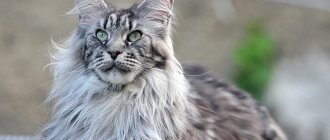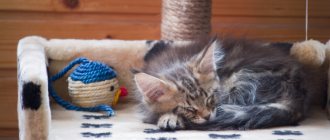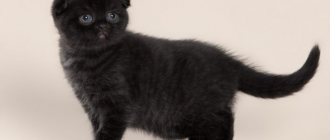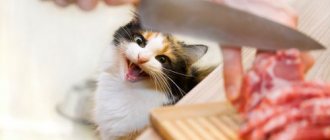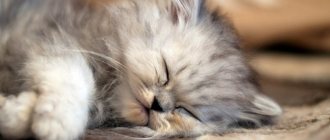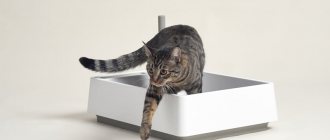How can you not worry about your kitten? He is so small and defenseless, he cannot tell his owner whether there is enough food or not. So the owner is trying: he constantly feeds the baby, because the poor thing is too thin.
What age is the baby? Three months? Great, we have to find out how much a kitten should weigh at 3 months. And after that, decide whether he is really skinny, or whether the owner decided so.
From birth to...
Before we get to our main task, let's talk about how cat babies gain weight.
Birth weight often does not reach 100 grams, unless we are talking about a large breed such as the Maine Coon. Kittens of these breeds weigh about 150 grams at birth.
During the first month of life, the baby gains weight 4-5 times its original weight. A one-month-old kitten already weighs 400-500 grams.
By the age of two months, its weight can be 600-700 g. Maine coons and other large breeds can weigh 900 g.
The normal weight of a kitten at 3 months is from 1200 to 1500 grams. But there are some factors to consider here. Which? We'll find out in the next subsection.
Some external features
All representatives of the breed, regardless of their color, place of residence and characteristics of care, have a number of appearance characteristics. Using them, you can determine the kitten’s species:
- Round head, wide cheekbones and short neck;
- Short and straight nose, small and low-set rounded ears;
- Big eyes;
- Grounded, massive body;
- Short, but quite thick paws;
- Thick, medium-sized tail;
- Short but very thick coat.
3 month old British babies © shutterstock
Factors affecting weight
It all starts from the moment the cat is pregnant. It is no secret that the further development of a kitten, including its weight, is influenced by intrauterine formation. Did the fetus receive the required amount of vitamins and nutrients?
- Nutrition of the expectant mother is a key factor in the formation of the fetus and its subsequent development.
- The nutritional value of mother's milk plays an important role.
- Does the baby have enough milk? If not, then he may be slightly behind in physical development from more “well-fed” kittens.
- Number of brothers and sisters. The larger the litter, the harder it is for the cat to feed it.
- Nutrition after weaning. It is clear that a stray kitten, which knows the feeling of hunger from an early age, will weigh less than its domestic counterpart.
- Seals are larger than female cats, so they will weigh more.
The weight of a 3-month-old kitten depends on such seemingly not very significant factors.
Why monitor the development of newborn kittens?
It is very important to monitor how newborn kittens develop and know how best to care for babies at different stages of their growth. This will help get rid of many problems associated with animal health.
During the first three weeks of kittens' lives, mother cats themselves feed and care for them. However, control over the full and timely development of small pets is the responsibility of the owner. To do this, you need to regularly weigh the kittens, and also know when they open their eyes, when their first teeth are cut, when they begin to hear, walk and eat solid food.
Mother cat takes care of newborn kittens herself
Breed and weight
Two friends decided to get cats. One bought a Maine Coon, and the second decided on a Siamese kitten. The “kids” are the same age and are fed very well. But why does the Maine Coon look like a lynx? Plump, heavy, pleasant to touch. And a representative of the Siamese breed resembles a skeleton: skinny, disproportionately long, and you can count the ribs.
Because the breeds are completely different. And this means that the weight of a kitten at 3 months of one breed will be significantly different from another.
So that the owners are not afraid of the “wrong” weight of their pet, they need to know this:
- At the age of three months, the Maine Coon weighs 1700-2300 grams.
- A Scottish kitten at the same age will weigh 1000-1500 grams.
- A British baby weighs the same as a Scottish baby.
- A Siamese kitten barely reaches a weight of 1000 grams.
- Sphynxes can weigh from 800 to 1300 grams.
- Ordinary noble representatives of cats - from 700 to 1000 grams.
Type of food and its features
A very important question is what to feed a British kitten for 3 months - ready-made food or natural food. When choosing the first option, you need to know that one manufacturer must be maintained throughout the development of the kitten, since each food has its own specific set of nutritional values and ingredients. If such a set changes, the British body may not yet be formed and refuse to accept the new food. If you choose natural food, it is worth noting that it is important to know the nuances of what you can and cannot give to your pet.
In addition, if you have chosen the option of buying a kitten in a nursery, then you need to inquire what method of feeding was chosen there for your animal.
Because it is advisable to continue to use the same dry food, but certain preferences may have already developed towards using a natural product.
Pathology
How much should a kitten weigh at 3 months of age? From 700 to 2300 grams. It depends on the breed. The average weight ranges from 1200 to 1500 grams.
What if the pet exceeds its weight category? A slight excess cannot be called critical. 100 grams is nonsense. In the case when a pet looks more like a small ball than a cute kitten, we are talking about a pathological weight disorder. And what should the owner do?
First of all, have your pet examined by a veterinarian. Cats are prone to diseases, the symptom of which is weight gain. If the veterinarian rules out their development, then you will have to reconsider the pet’s diet. He also diagnoses obesity in the baby.
Same problem, only from the other side. The kitten does not weigh enough. But at the same time he is active, mobile, curious and has a good appetite. It wouldn't hurt to visit a veterinarian. Has the cat and dog doctor ruled out diseases? Great, people can be too thin too. They eat pretty well though. You should not try to fatten the kitten, let him eat as much as he wants.
Tips for keeping your kitten healthy
Veterinarians recommend the following ways to maintain the health of a kitten:
- Study the movements and reactions of the kitten to immediately understand if he suddenly gets sick and immediately contact a veterinarian;
- Provide your kitten with proper nutrition by choosing a balanced diet appropriate for the animal’s age;
- Kittens need to sleep a lot, so provide your pet with a quiet and comfortable place to rest;
- Never wake a sleeping kitten;
- Take time to play with the kitten, as it needs communication and physical activity;
- Always stick to your vaccination schedule.
The first months of a kitten’s life are a time of intensive growth and development. By taking care of your pet's health at this stage, you can lay the foundation for a healthy kitten life in the future.
Feeding and maintenance
We found out how much a kitten should weigh at 3 months. Now let's talk about how to feed the little furry little prankster. And how to care for it.
Let's start with nutrition. The owner needs to remember that a lot depends on a balanced diet. Please do not feed your baby with economy class kitten food. Yes, they are available and cheap. But the quality is lacking on both legs. Feeding a kitten this kind of food is the same as feeding a human child instant noodles. Is there much use in it? And how long will you be healthy enough to digest this crap?
What if you don’t have money for good food? He's expensive. Feed natural food, this is not a problem. Chicken and turkey are not the most expensive meats. Vegetables and cereals are also not incredibly expensive products.
Milk is getting more expensive, it’s true. But there is no need to give milk to a three-month-old animal every day. It won't do any good. Three times a week you can pamper yourself with kefir and cottage cheese. Once a week, give a boiled egg, or rather a half or a quarter of it.
Did the owner finally decide to feed? Let him choose super-premium class or holistic. They are not cheap, but the quality is simply excellent.
We sorted out the diet. Let's move on to the content. What does the baby need?
- A lounger or a rest house. The kitten will sleep in it and hide when it needs to be alone.
- Scratching post. You can buy the simplest one, mounted on the wall. Or you can take a whole cat town with a scratching post, a house and toys. It all depends on the financial situation of the owners.
- Bowl for water and food.
- Toys.
- Nail clippers or nail scissors. Useful from the age of six months for trimming nails.
- Cotton swabs. Needed to remove discharge from the eyes. The kitten is examined daily. The owner checks the cleanliness of the ears and eyes. Dirt and discharge are removed using a dampened swab. The ears are cleaned with cotton swabs.
- We now know how much a kitten should weigh at 3 months. By the way, scales will be very useful for him.
- Tray and filler. The kitten has done its business, the spoiled litter is removed immediately, and a new one is added in its place.
Long-haired breeds require regular brushing. Kittens and cats should not be washed frequently. Twice a year is enough.
The main thing about a kitten from three to six months
Habits and character
A kitten at three months is quite independent. Usually the baby is already accustomed to the tray, uses a scratching post, and has successfully switched from mother's milk to kitten food. Breeders often start giving away kittens from the age of three months.
If you become the proud owner of a furry four-legged friend, make sure that the veterinary passport contains notes on the necessary vaccinations. Find out in detail what he was fed recently. Experts advise that after moving to a new place of residence, do not disturb the kitten too much and feed it for the first 10 days with the same thing that the baby was fed before. For a baby, a new home is very stressful. If you don’t put pressure on your ward, he will soon begin to explore the surrounding space on his own.
Games and communication will help you make friends with a new family member. Toys for little kittens are an opportunity to develop hunting skills, socialize, and get comfortable. Felinologists recommend light toys for kittens - such that the baby does not have to work hard to toss the toy with his paws. Toys should not be small or too hard - at the moment of changing baby teeth to molars, your child will probably want to chew on them. It is important that they do not have parts that can be chewed off and swallowed. It is better to purchase toys for small kittens at a pet store - this guarantees you the quality and safe composition of the product.
At the age of three to six months, the muscular and bone skeleton is actively formed. Toys such as mice and laser pointers will help develop mobility and strengthen muscles. If the kitten guesses that you are in charge of the process, put the game aside for a while. By the next time, the baby will have already forgotten about his guess and will start chasing the bait again.
You can purchase a whole play set for a kitten at a pet store. Even if you are not nearby, the kitten will be able to train and move - climb on special posts and platforms installed at different heights. Whatever the toys for your pet, the most important thing is to use them more often in play and communication with your four-legged friend. Kittens desperately need affection, attention from their owner, and active games.
Surround your baby with your care and love. But do not forget that from the first days in the new home he needs to be gradually and gently taught the rules of communication with family members and the rules of behavior in the house, convey what can and cannot be done.
The main thing is, under no circumstances punish the kitten or use physical force. Babies have a short-term memory, and after just a few seconds of misconduct, the baby will completely forget about what he did and your dissatisfaction will become a bolt from the blue for him. Kittens subtly sense the state of their owner, respond sensitively to him - and punishment will really become a huge stress for him, which will undermine his trust in you.
This does not mean that all missteps need to be let off the kitten’s paws. You just need to act smoothly and carefully. Forget about using force - it never leads to anything good. It is better to work with intonation, clapping, and, as a last resort, “scare” the kitten with a spray bottle. Stop unwanted behavior only when you catch the kitten in the act. For example, when he sits down to do his business in the wrong place. But after a couple of minutes after this, reprimanding is completely pointless.
Be friendly, but confident and consistent. If you forbid something to a kitten, then forbid it forever. Do not make concessions, otherwise the baby will never understand what behavior is correct. Do not allow your pet to bite or scratch your hands even during play - so that this habit does not continue in the future. It is unlikely that you will like it if an already matured cat jokingly mistakes you for a palm tree and climbs up your leg, leaving red marks.
Teeth and nutrition
In the period from three to six months, not only muscles and bones grow, but also the teeth of the little hunter. At three months, a kitten has a full set of 26 baby teeth. At three to five months, they will gradually begin to be replaced by indigenous ones. The process will be completed by approximately eight months of age. Examine your pet's teeth. The change from milk to molar usually goes smoothly in kittens, but minor problems such as swollen gums are best detected in a timely manner.
Decide on the kitten's feeding schedule. This can be special ready-made food for kittens or food “from the table”. Complete food is developed taking into account all the needs of the developing kitten's body. Choose the highest quality food - this is the key to your pet’s health. The packaging always indicates the age of the kitten by month, so be sure to pay attention to this. The table feeding plan should be discussed with your veterinarian. In this case, in addition to food, the baby will need vitamins. Don't forget to provide your baby with constant access to clean, fresh drinking water.
How many times a day should you feed your kitten? At three months, it is absolutely normal to feed your baby five to seven small meals a day. At four months you can switch your pet to four meals a day. By five months, your child is ready to switch to three meals a day. Make sure your baby eats well, but does not overeat. With the right diet, the kitten will grow up healthy, beautiful and will not suffer from excess weight, as well as other diseases that overeating can cause.
Development and health
Typically, kittens begin to receive their first vaccinations against infectious diseases at two months of age. The drugs are produced in the form of complex vaccines containing 3-4 components, this allows several injections to be replaced with one. Revaccination is carried out after three weeks. As a rule, breeders carry out these procedures before transferring the kitten to new owners. If for some reason the vaccinations were not done, then they need to be done as soon as possible.
Rabies vaccination is recommended at 3-4 months of age. The pet's vaccination schedule can be adjusted by the veterinarian depending on the chosen drug (vaccine). Vaccination is carried out only to clinically healthy animals.
Even if the kitten’s veterinary passport contains notes on all necessary vaccinations and treatments, carefully follow the schedule of revaccinations and treatment against external and internal parasites. Revaccinations after the first year of life are then performed once a year. The choice of vaccination schedule and required types of vaccines is made only by a veterinarian.
At six months, kittens gradually begin puberty. At the age of 7 to 10 months (less often at the age of one year), cats begin their first heat. This is how puberty begins, but this does not mean that the young cat is ready to become a mother. The body continues to form, so it is recommended to breed a cat only after several heats. Some owners prefer to sterilize at the age of six months. This can be done a little later, but the older the cat is, the more difficult it will be for her to undergo the operation. Males are usually neutered at the age of eight to ten months, preferably before one year of age.
A teenage kitten needs to be taught regular hygiene procedures. If you need to examine and rinse or clean the kitten’s eyes and ears, praise your ward and speak kindly to him. Finish the ritual with praise and a treat for your pet.
The same goes for combing. A slicker or furminator should not frighten the kitten. If you first play, praise and treat your baby with something, he will perceive the brushing as a sign of your attention to him. A small kitten has almost nothing to comb. But a teenage kitten will begin its first molt at the age of five to eight months. If combing is something familiar for your ward, then changing the fur to an adult will not be accompanied by hairballs throughout the house. The danger is that your four-legged friend may swallow his own fur.
By the time the baby molts, the baby's color will begin to even out a little. By 10 months, your pet's color will be almost final. Kittens develop eye color by four months. Then it may become somewhat richer.
Already at 4-8 weeks of life, kittens can have their first nail trimming. This is done to prevent kids from injuring each other while playing. If you have never shortened a kitten’s claws before, it is better to entrust it to a specialist, at least for the first time. At home, your pet will be able to scratch the scratching post. Most kittens are advised to buy a horizontal scratching post - this will make it easier for the baby to reach.
After three months, the kitten stops growing rapidly and changing every week. By six months his growth slows down. Then it will get stronger, muscles will develop, and the fat layer will increase slightly. But if you have already managed to raise an active, intelligent, healthy six-month-old kitten, then you have overcome the most difficult challenges together and become true friends.
How to choose the right diet and dose of food?
After you select the optimal diet for your pet, you need to consider the frequency and method of feeding. All feeds are of high quality and have dosage recommendations. Typically, the weight of the dose depends on the activity, size and (in rare cases) breed of the animal.
To make sure that your pet has enough of the selected daily allowance, it must be weighed regularly. It is important to understand that at three months of age, not all kittens can control their appetite. If the kitten is full and leaves food in the bowl, most likely the portion is too large.
If you are determined to feed your kitten dry food, you need to do it correctly.
Until the baby's molars erupt, the food granules must be soaked before feeding. 10–15 minutes before serving, they must be filled with hot water. The granules will swell and increase in size. They can be chopped into smaller pieces before serving.
Tip: To encourage your pet to eat dry food, it must be served warm. Another method of stimulating appetite is to add gravy and wet food to soaked dry food.
By switching your kitten to dry food, you automatically give up a natural diet. It is strictly not recommended to mix industrial and natural food, especially while the kitten’s gastrointestinal tract is unstable.
Mixing is not recommended within the same or daily feeding. That is, you do not need to give your kitten dry food in the morning and milk or other natural products in the evening.
Remember! Ignoring this rule will lead to incomplete absorption of food, growth retardation and other negative consequences.
What not to feed a kitten
Some owners who do not know how to properly feed kittens give them foods that are undesirable for consumption.
- Salted, fried, smoked, peppered, spicy, fatty. These foods cause inflammation of the digestive tract.
- Milk. At the age of 3-4 months, it is better to give it up, since the kitten’s digestive tract is no longer able to digest lactose.
- Citrus. They are not digestible in cats. Moreover, they cause irritation of the mucous membrane of the stomach and esophagus, which leads to an attack of vomiting followed by dehydration.
- Bones. Cats chew bones into many fragments, which pass through the gastrointestinal tract and injure the mucous membrane. As a result, bleeding may occur.
- Chocolate and other sweets. They have a toxic effect on the kitten’s body.
- Vegetables of the nightshade family, as well as onions and garlic. The body does not digest these foods.
- Avocado, grapes and raisins. They contain a poisonous toxin.
Amount of water when feeding a kitten dry food
In order for the kitten’s body systems to function at a high level, along with the necessary substances, the minerals contained in the water must also be supplied.
Water, in itself, is not a source of energy, but is a special substance necessary for the passage of biochemical reactions, serves as a natural solvent, and takes part in the processes of respiration, blood circulation and, of course, digestion.
When your pet consumes dry food, the amount of drinking water should be unlimited. So, you should not force a cat to drink water, but there should always be access to water. Otherwise, there is a high risk of serious diseases associated with disruption of the urinary system. First of all, when there is a lack of fluid in the body, it is the kidney structures that suffer.
